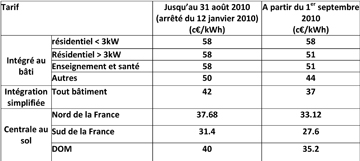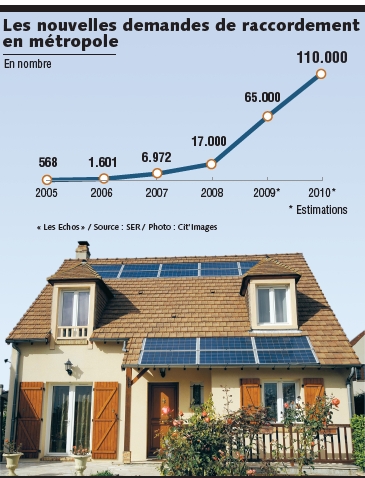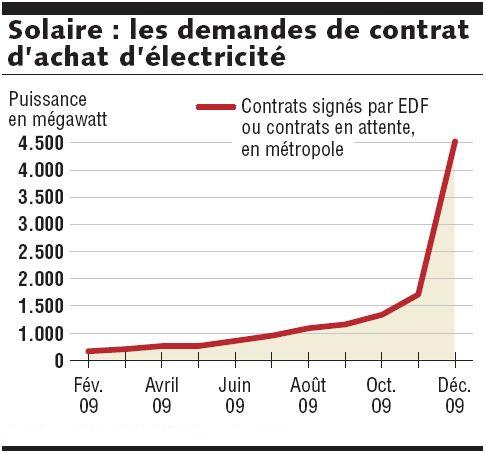Pending official clarification, here are 2 articles:
Arm wrestling over new solar electricity tariffs
The government has still not published the new purchase prices for photovoltaic electricity by EDF. The players in the sector oppose those who want to prevent the owners of solar installations from reaping "super-profits".
How to develop the solar sector without it costing the consumer or the taxpayer too much? This is the thorny issue facing the government. So thorny that he struggles to make decisions on the subject. In principle, the ministerial decree fixing the new feed-in tariffs for the electricity that will be produced by future photovoltaic installations - data absolutely essential for the future of the French solar industry - was due to be published at the end of December, in order to come into force in January 1st. But these tariffs, which set the prices at which EDF will be obliged to buy back the electricity produced by a photovoltaic installation for twenty years, are still pending. Since September, the versions follow one another. And the final decree is not yet signed, let alone published in the "Official Journal", to the chagrin of professionals in the sector, suspended from this arbitration.
The government has been pondering the issue for months. In September, the Ministry of Ecology had publicly presented a draft decree on the subject, before reviewing its copy several times. This new delay is symptomatic of the standoff between players in the sector and those who wish to prevent owners of photovoltaic installations from reaping "super-profits" thanks to public subsidies.
Equipment prices drop
In mid-December, the government had already modified its project following an opinion from the Energy Regulatory Commission (CRE), which stressed the high profitability that photovoltaic installations would have with the new tariff, and its cost for the community. The deficit between the price of photovoltaic electricity paid by EDF and invoiced to individuals is in fact covered via a contribution to the public electricity service (CSPE). "A return on invested capital of 7 to 8% is already a very incentive," said the Commission in its opinion, which has not been officially published. "For individuals, the internal rate of return on projects is, on average, 15,2%", adds the Commission. A figure deemed "delusional" by some players who consider that it does not take into account the costs of capital financing.
However, everyone agrees that the sharp drop in the price of photovoltaic equipment (around 30% in 2009) justifies a reduction in the prices of the electricity they make it possible to produce. It remains to find the right cursor. Whatever they are, the new rates will not in all cases concern installations already in service.
Today, the industry says it is completely calm about the results of the races. “On December 22, the government presented an extremely detailed draft decree to the Higher Energy Council. I do not imagine that this decree is not published with some modifications of details close, explained the president of the union of renewable energies, André Antolini, on LCI. This draft decree provides for a buy-back rate of 0,58 euro cents per kWh for installations "integrated into the frame", that is to say ensuring a waterproofing of the roof, mounted on dwellings, offices , educational or health buildings. The price drops to 0,50 euro cents per kWh for other sites. Finally, an intermediate tariff is created for buildings with “simplified integration”, that is to say when the panels are simply placed on the roof, but do not guarantee watertightness, like agricultural sheds. According to some specialists, the delay in the publication of the decision is in particular linked to the government's questions about the regionalization of the prices of ground photovoltaic power plants. In September, the Ministry of Ecology had published a draft decree, which marked the introduction of a modulation of the feed-in tariffs for ground installations with a power greater than 250 kWp. This provision was aimed at achieving better geographic modulation of the ground power plants. It was notably defended by EDF Energies Nouvelles, which played a decisive role in the creation of a solar panel factory at First Solar in France. But this strategy is not necessarily unanimous. “Within the sector as well as the State, two visions clash. Those who defend a centralizing vision of photovoltaics with the creation of ground-based power plants, and the proponents of decentralization who rather bet on a multiplication of on-roof installations. These two visions are not necessarily incompatible, but they do require budgetary choices, ”explains an expert. After the failure of the carbon tax and a few months before the regional elections, the implementation of a “less ecological” decree can also raise questions on the political level. Enough to give yourself a few more days of reflection before making a decision.
EMMANUEL GRASLAND, Les Echos
Source: http://www.lesechos.fr/info/energie/020300773920.htm
Case to follow so ... I already found this on
2010 purchase prices (decree of July 2006)
5th January 2010
While waiting for the eagerly awaited "new tariff decree", here are the purchase prices for the complete requests for a purchase contract Purchase contract Contract which manages the contractual relationship between the photovoltaic producer and the buyer. The purchase contract is issued by EDF AOA (Agence Obligation d'Achat) or a Local Distribution Company (ELD). carried out from 01/01/2010, with a K coefficient equal to 1,05006.
The PPEI index has dropped by almost 8% since the calculation of the purchase price The electricity purchase price The price at which photovoltaic electricity is purchased. The tariff is fixed by decree 2009, hence the significant drop in the tariff.
Metropolis
Basic rate T = 31,502 c € / kWh
Basic rate with integration premium T + I = 57,753 c € / kWh
Corsica, DOM, St Pierre and Miquelon
Basic rate T = 42,002 c € / kWh
Basic rate with integration premium T + I = 57,753 c € / kWh
Source: http://www.photovoltaique.info/Actu.html
Wait & see ...
Edit here is the office update in 10/2010:




